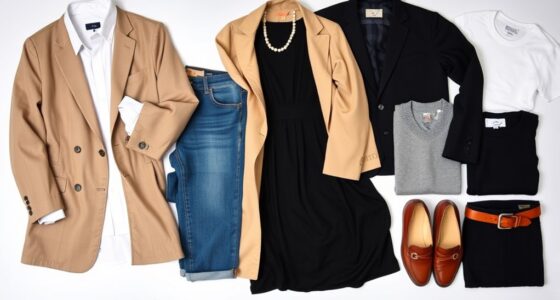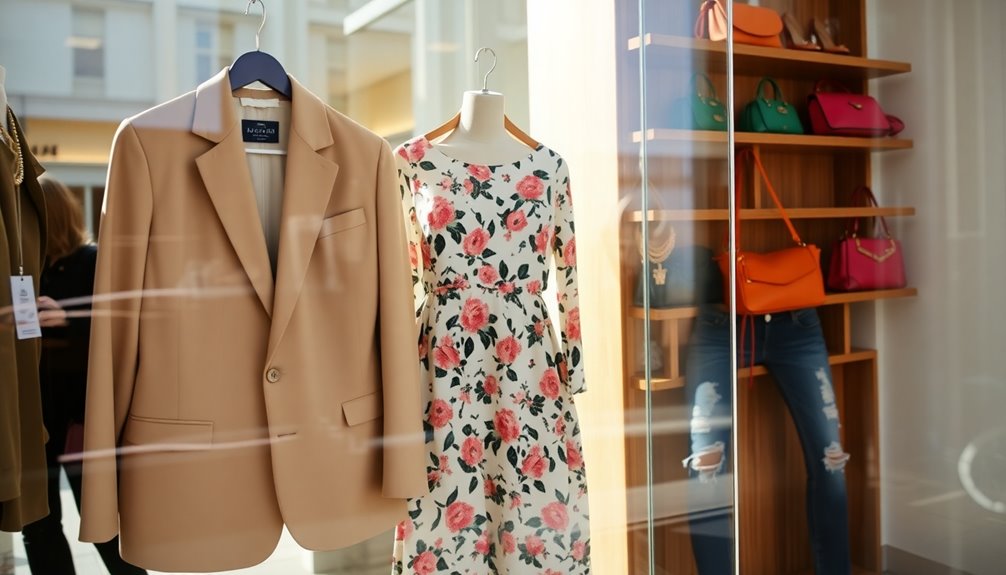Knowing when to splurge and when to save helps you make smarter choices. Save on essentials like groceries and everyday clothing with budget-friendly options that offer good quality. Reserve splurges for items like luxury or long-lasting products that bring value and joy. Focus on investing in timeless, durable pieces instead of trendy, short-term buys. By balancing discounts, sales, and thoughtful spending, you’ll maximize satisfaction and financial stability. Keep exploring for more expert tips on mastering your shopping habits.
Key Takeaways
- Prioritize splurging on high-quality, durable items that serve long-term needs or bring significant personal value.
- Save on trendy, seasonal, or non-essential items that are likely to be replaced or go out of style quickly.
- Consider your lifestyle and health needs—spend more on comfortable, reliable essentials that enhance daily well-being.
- Use discounts, sales, and lesser-known brands to get quality products at a lower cost without sacrificing longevity.
- Make informed decisions by weighing long-term benefits and personal values before splurging or saving.

Smart shopping can save you money and reduce stress, but it requires a strategic approach. Knowing when to splurge and when to save can make a significant difference in your finances and satisfaction. One of the most common dilemmas is balancing budget vs. luxury. When you’re shopping, ask yourself whether the item is a necessity or a luxury. For essentials like groceries, household items, or basic clothing, sticking to your budget is wise. These are areas where cutting costs doesn’t compromise your happiness much, and you can find quality products at affordable prices. On the other hand, when it comes to special occasions or items that offer long-term value—like a well-made couch or a quality pair of shoes—it might be worth investing in luxury or higher-end brands. Here, the difference between brand vs. quality plays a pivotal role. Sometimes, paying a premium for a trusted brand guarantees durability and better craftsmanship, which can save you money in the long run. But be cautious; not everything branded is necessarily better. Do your research to ensure that a higher price translates into better quality and not just a name.
Knowing when to spend and when to save also involves evaluating the longevity and utility of your purchases. For example, if a shirt is trendy and cheap, it might serve you well for a season, but a higher-quality, more expensive piece could last several years. When making these decisions, consider your personal values and lifestyle needs. If you prioritize durability and timeless style, splurging on quality over brand name is often the smarter move. Conversely, if you’re shopping for something that’s trendy or seasonal, sticking to your budget and opting for less expensive options is perfectly reasonable. Additionally, incorporating lifestyle considerations like health and comfort can help guide your purchasing decisions to better align with your overall well-being.
Another key aspect of smart shopping is recognizing the difference between brand vs. quality and understanding how to leverage discounts and sales. Sometimes, a lesser-known brand offers comparable quality at a lower price, giving you the best of both worlds. When it comes to luxury, wait for sales or special deals to get the most value out of your investment. Remember, splurging doesn’t mean overspending; it means making thoughtful choices that align with your priorities. By carefully evaluating each purchase and considering the long-term benefits versus immediate gratification, you’ll develop a balanced approach that keeps your budget in check while allowing room for occasional indulgences. Smart shopping isn’t just about saving money; it’s about making informed choices that lead to greater satisfaction and financial stability.
Frequently Asked Questions
How Can I Identify Genuine Quality Versus Overhyped Products?
To spot genuine quality versus overhyped products, start by researching luxury branding to understand what authentic features look like. Check product reviews from trusted sources to see real-world experiences, and compare details like materials and craftsmanship. Be cautious of exaggerated claims or flashy packaging. When you combine knowledge of luxury branding with honest reviews, you’ll make smarter decisions and avoid falling for hype over true quality.
What Are the Best Times of Year to Find Deals?
Think of shopping seasons as treasure hunts, where timing is your map. You’ll find golden opportunities during seasonal sales and holiday discounts, when stores roll out their biggest deals. Black Friday and end-of-season clearance events are especially ripe for savings. To strike gold, plan ahead, mark your calendar, and stay alert for flash sales. These peak times turn ordinary shopping into a savvy quest for quality without overspending.
How Do I Stick to a Shopping Budget Without Missing Out?
To stick to your shopping budget without missing out, prioritize your shopping list and set clear limits for luxury vs. budget items. Focus on essentials first, then allocate extra for splurges if your budget allows. Use price comparison tools and look for deals. This way, you enjoy quality without overspending, balancing luxury and budget needs while ensuring you don’t miss out on what matters most to you.
Are There Specific Brands That Consistently Offer Better Value?
Think of brands like reliable friends, always showing up when you need them. Some brands consistently offer better value because of their strong reputation and fair pricing. You should compare prices and read reviews to spot those that deliver quality at a reasonable cost. While no brand is perfect, researching and doing price comparisons helps you find brands that give you more bang for your buck, making your shopping smarter.
How Can I Avoid Impulse Purchases When Shopping?
To avoid impulse purchases, practice mindful shopping by sticking to a shopping list and setting a budget beforehand. Take a moment to pause and ask yourself if you really need the item or if it’s just an emotional urge. Avoid shopping when you’re hungry or stressed, and give yourself time to think over big purchases. This approach helps you stay focused and make smarter choices that align with your financial goals.
Conclusion
Think of your budget like a garden—you wouldn’t plant expensive flowers in poor soil or waste water on weeds. By knowing when to splurge on quality and when to save on basics, you nurture a thriving financial garden. I once splurged on a sturdy backpack for a trip, and it lasted years, proving sometimes investing a little more pays off. Mastering when to save and when to splurge keeps your money blooming beautifully.










